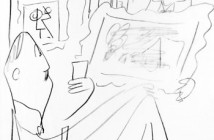Q: As an Italian artist based in Italy, do you think I have any chance at all to get representation in the U.S.? If so, how should I go about it?
A: Dear Italian Artist,
Get ready for some brutal truth. We all know how difficult it is to get an exhibition with a local gallery. You certainly decrease your chances as you cross statelines…and oceans. To make your chances worse, some galleries will only show locally based artists. These dealers like the convenience of having the artist close-by (for quick conversations and to save money on shipping), and sometimes it’s difficult to convince collectors to invest in artwork by artists in other regions (it’s hard for collectors to track their investments if the artist is in another state). But, there are galleries that are known for doing the reverse. Do some research to find out which galleries have a reputation for exhibiting “foreign” artists.
My advice to you and anyone else struggling to gain recognition, would be to enter as many group shows as you can. Check out websites like theartlist.com and artdeadline.com which announce juried exhibitions, and start sending submissions. Of course, you should research each institution and check their reputation before joining any exhibition. Hopefully, once in these group shows, you can start to pad your resume with North American exhibitions, and you increase the odds of having a U.S. dealer spot the work.
Generally, I have always felt like the most productive way for an artist to begin a career is to start locally and make a big impact on the closest art community. Then, spread your work like a virus, pushing your work outward to nearby cities, states and then countries. Although this may take time, it is a much more natural process then trying to start at several different locations throughout the world at once.
And, I hope your work doesn’t suck. This will also make things more difficult.
----
Q: In your last column, you stated the following:
“… Typically, a gallery will take 50% of any sales made. This may vary 10% in either direction depending on the gallery. Often times, non-profit spaces or galleries featuring group shows may only ask for 25%. Generally, an artist should expect to make only half of what they would selling their work out of their own studio…”
If I have an exhibition at a gallery, can I then sell the unsold works at a discounted price at my studio to make them more marketable? Can you please elaborate a little on pricing in the studio versus the gallery?
A: I will admit that when I saw this question, I got a little nervous. How can I answer such a complicated issue in my very small (but enormously appreciated) column? We could dedicate an entire website to artist and gallery pricing dilemmas. But, I’m always up for a challenge, and I anticipated some discussion regarding this issue.
So, being in a visual industry, I thought maybe the best way to elaborate on all of the different scenarios would be to create a chart. On the left side of my “chart-o-pricing,” I would have the level of committment between the gallery and the artist ranging from “non-exclusive” to “exclusive” with about three other relationships in between. Then, on the top, maybe the different opportunities an artist will have to make sales in spaces other than the gallery, like sales to friends and studio sales. In the middle, some sort of indicators marking the importance of each to a gallery. Once my chart was complete, I wanted to vomit. It looked ridiculous and it made no sense. I decided to sleep on it.
The next morning, I went over to my desk, took another look at the chart (and some internet porn to clear my head), when it hit me…This chart is irrelevant, as was its attempt to clarify the different scenarios. Conclusion? When it comes to pricing, under no circumstance is it OK to undersell a gallery that has exhibited your work.
Without getting too crazy explaining why, here is one stupidly important reason: If a collector knows that he/she can purchase artwork at a discount from the artist’s studio, they will not purchase artwork from the gallery. If there is no sale at the gallery, the dealer will will not make any money and will go out of business. Without a gallery…Well, you get the point.
There are collectors out there that bank (literally) on an artist’s inexperience and will cruise “Open Studios” for less expensive deals. As an artist, you will also find that collectors want to make private “studio visits,” which really means that they want to purchase work directly from you, hoping that they will get an artwork at a signifant discount (without the gallery in the picture). The reality is that once you establish a price point within a gallery, that should be the price of your work regardless of where and when it is sold. I’m not talking about a 10-15% discount, which can be found in a gallery anyway, but truly, anything beyond 25% is insulting to your reputation and your gallery. And, don’t forget, if you make a connection with someone because of an exhibition, you should always reward the gallery with their commission, or better yet, have them handle the sale. Keep the collectors honest, and your gallery happy and in business.
Image courtesy of Wikipedia.
 "Advice For Artists" can be read in series in
"Advice For Artists" can be read in series in
the Big RED & Shiny Collections section.





